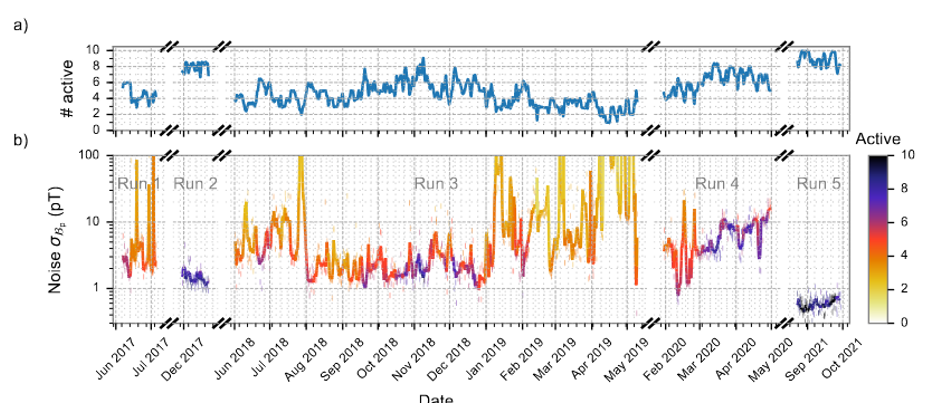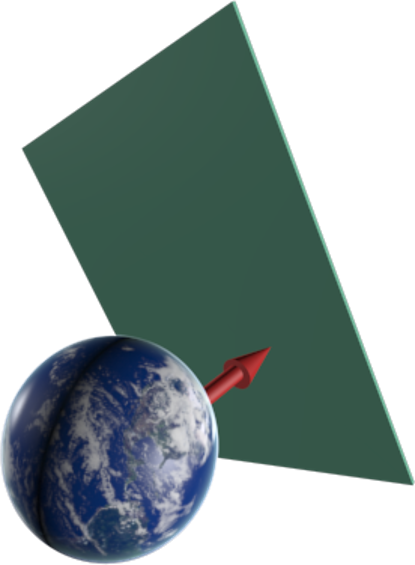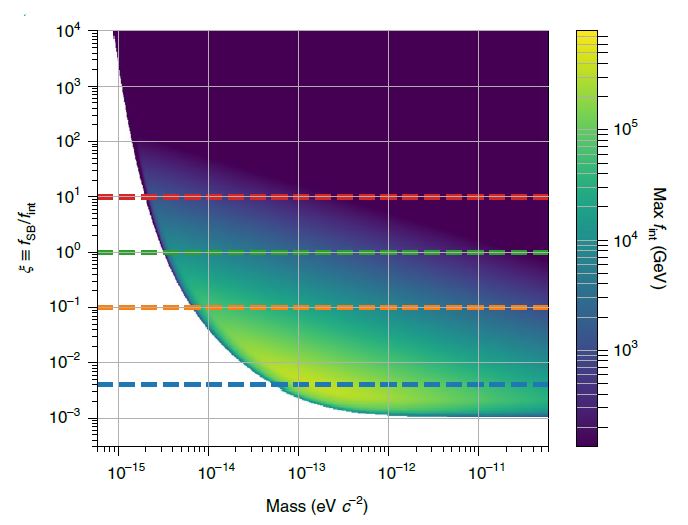Optical magnetometers are the most sensitive magnetic-field sensors known today. With femtotesla-level sensitivity, kilohertz bandwidth, and a dynamic range extending up to the Earth's field, the sensors currently find application in medical imaging, surveys for natural resources, and navigation, but also in the pursuit of physics beyond the Standard Model and quantum-state engineering.
SZYMON PUSTELNY
Scientist, entrepreneur, husband, and father
QUANTUM SENSING OF MAGNETIC FIELDS
OPTICAL MAGNETOMETRY
INTRODUCTION
Observing light properties in a medium subjected to an external magnetic field represents one of the most sensitive contemporary magnetometric techniques. With femtotesla-level sensitivity, a bandwidth of about a hundred hertz, and a dynamic range up to 100 nT or 100 µT (depending on the arrangement), this technology facilitates a myriad of applications. From medical imaging and surveys for natural resources to navigation and searches for electric dipole moment, monopole-dipole coupling, and ultralight dark matter, its versatility is paramount in advancing scientific exploration and technological innovation.
ULTRALIGHT DARK MATTER WITH PSEUDOCALAR SPIN COUPLING
Some dark-matter models predict that dark matter is made up of extremely light particles – ultralight bosons. Due to their low mass, orders of magnitude smaller than the lighest known Standard Model particles (neutrinos), they bahave more like (coherent or incoherent) fields rather than single quantum objects.
Many mechanisms of interaction of the particles with ordinary matter are postulated, one of which is through pseudoscalar coupling with spins. This interaction could cause changes similar to those induced by magnetic fields. This makes optical magnetometers a powerful tool to search for the dark matter.
TRANSIENT AND OSCILLATORY SIGNALS
Many conventional searches for dark matter are based on long-term measurements and building statistics to reduce noise and retrieve the signal of interest. The searches implicitly assume that dark-matter induced effects that do not change over time. However, if the exotic signals are time dependent, for example, if they oscillate or only appears temporarily, traditional methods may not be effective, and the signals can remain undetectable, being washed out due to averaging. In this case new methods to search for dark matter, particularly that consisting of ultralight bosons, needs to be developed. This is the problem addressed with the Global Network of Optical Magnetometers for Exotic physics searches.
GNOME
The Global Network of Optical Magnetometers for Exotic physics searches (GNOME) is a worldwide collaboration of more than a dozen scientific organizations working together to study signals from magnetically-shielded atomic sensors (e.g., optical atomic magnetometers). Assuming that exotic particles pass through the sensor network, e.g., because of Earth motion, and penetrate through the magnetic shieldings, the interaction with the sensors leads to generation of time-dependent signal pattern arising across the whole network. By analyzing signals from multiply sensors, sensor stochastic noise can be reduced and hence global scale spin perturbation can be identified. Moreover, using the approach a perturbation propagation direction can be determined enabling identification of its source. This way GNOME reinforces multimessenger astronomy, arming it with a new information channel proving (potential) information of exotic couplings.

GNOME CAMPAIGNS
Over the years, the GNOME collaboration conducted numerous measurements campaigns. With a growing number of operational sensors, our network has reached a sensitivity of 1 pT (spin coupling recalculated into magnetic-field units) within a 100 Hz bandwidth, making the most advanced sensor of its kind. This has allowed us to search for novel dark-matter candidates and interactions, setting new limits on the pseudoscalar spin coupling between dark and ordinary matter.
DARK-MATTER DOMAIN WALLS
A specific theoretical proposal of ultralight bosonic dark matter that the GNOME collaboration has analyzed in depth is the model of a dark-matter domain structure of the so-called axion-like field (as the bosons are ultralight they manifest their exitance more as a field than individual particles). This theory proposes that fluctuations in the field in the early Universe resulted in the formation of the nonuniform field – a domain structure. Due to its nature, the scalar coupling of the field prevents from the axion-field to be detected with optical atomic magnetometers when inside individual domains. However, transition through a boundary between two domains (domain wall) generates the gradient of the field that can couple to spins and hence the filed can be detected by our netowrk of optical atomic sensors.


LIMITS ON DOMAIN WALLS
To explore the dark-matter domain structure of the axion-like field, we used the results of one of our measurement campaigns. Our search was based on identification of common transient signals from multiple magnetometers, fulfilling a specific amplitude-temporal pattern (sensors are spatially separated with their sensitive axes oriented in different directions). This allowed us to probe the mass ma and pseudoscalar coupling strength fint of axion-like particles to ordinary matter. Our results set new limits on these interactions and marked the first scientific results from GNOME. These findings demonstrate the power of the GNOME network in exploring the mysteries of dark matter.
BEYOND DOMAIN-WALL SEARCHES
While domain-wall search was the first application of GNOME, GNOME’s exploration of dark-matter models is far from being over. In the future, we will be testing other models, including the presence of dark planets, dark-matter trapped in the Earth’s gravitational field, and the emission of jets of exotic particles during catastrophic astrophysical events like black hole mergers and supernovae. The analysis of already recorded signals is underway, and the results of the searches will be presented soon.
ADVANCED GNOME
Our group works on the development of novel GNOME sensors that are highly sensitive to nonmagnetic interactions. While optical atomic magnetometers are excellent at measuring magnetic fields with extreme sensitivity, they are also susceptible to magnetic noise that affect our nonmagnetic searches. To tackle this issue, we have developed a sensor known as the self-compensating comagnetometer. This device effectively reduces low frequency noise (signal baseline drift), which has been a significant hindrance in our searches. With the implementation of this new sensor, not only will our searches be more sensitive due to the reduction in noise, but it will also enhance our searches for proton and neutron pseudoscalar spin couplings by several orders of magnitude due to the use of uncoupled nucleon gases like helium. The first incarnation of Advanced GNOME, which features several of these new sensors, began operation in 2023.
SUMMARY
Selected publications
Books and publications:
A. Derivianko and S. Pustelny, Global sensor networks as probes for dark sector, In: D. F. Jackson Kimball, D.F., K. van Bibber, K. (eds) The Search for Ultralight Bosonic Dark Matter, Springer (2023) – Full free version.
Selected articles:.
- M. Padniuk. M. Kopciuch, R. Capolletti, A. Wickenbrock, D. Budker and S. Pustelny, Response of atomic-based sensors to magnetic and nonmagnetic perturbations, Scientific Reports 12, 324 (2022) – Full free version.
- S. Afach et al., Search for topological defect dark matter using the global network of optical magnetometers for exotic physics searches (GNOME), Nature Physics 17, 1396-1401 (2021) – Full free version.
C. Dailey, C. Bradley, D. F. Jackson Kimball, I. A. Sulai, , A. Wickenbrock, and A. Derevianko, Quantum sensor networks as exotic field telescopes for multi-messenger astronomy, Nature Astronomy 5, 150-158 (2021) – Published version and Preprint.
D. Budker, D. F. Jackson Kimball and S. Pustelny, Seeking a passage through the uknown, CERN Courier 7 (2023) – Free full version.